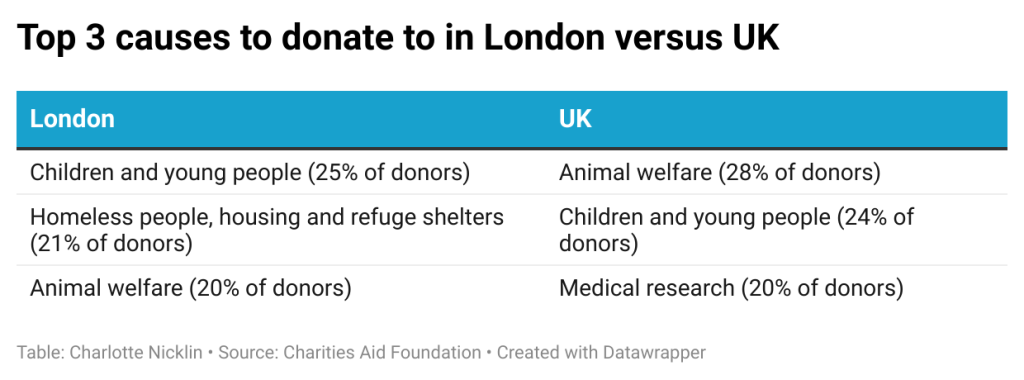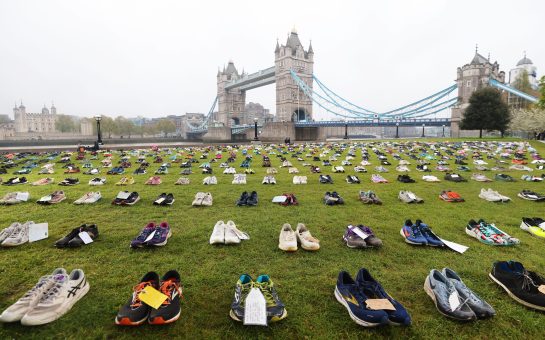London is the least generous UK city as a proportion of people’s income, a UK Giving Report from the Charities Aid Foundation has found.
The report, released in March, revealed that on average Londoners give 1.3% of their disposable income in comparison to other cities like Cardiff who donate 2.1% and Belfast who donate 2.5%.
It examined a variety of charitable giving factors: including the number of people doing charitable activities, how people are influenced to choose a charity and the estimated donations made by constituencies.
Catherine Mahoney, Senior Research Manager, for the UK Giving Report said: “We’re talking about generosity as a proportion of income.
“There’s a higher cost of living so even with much higher salaries a lot of disposable income is not always disposable, is it?
“London has a large number of people who commute in but don’t actually live there so it’s less easy to figure out what the need is around you and how to tap into it and support it.”
The report found that some of the least affluent parts of the UK are amongst the most generous, with Scotland, Wales and Northern Ireland being greatly overrepresented in the country’s top 100 most generous constituencies.
Mahoney explained that the survey has been running in this particular way since 2016 and has seen trends in people giving more to charity than before.
She added: “A trend we’ve seen is that the mean average donation has been increasing over time quite a bit, while the number of donors has been decreasing.
“Around COVID times, we saw the levels of donors entrench and it’s never really gone back to what it was before.”
Donations versus average annual income
Data from the Office of National Statistics (ONS) released in 2023 shows the annual average income per borough 2023/22.
Lambeth had the highest percentage of donations as a percentage of income at 1.7%, while Kensington & Chelsea had the lowest at 0.5%.
The average annual income for 2022/23 showed the City of London and Tower Hamlets boroughs having the highest annual incomes at £96,244 and £79,994 respectively.
Lambeth borough came in fifth place with an average annual income of £52,870, estimating a total of £898.79 made for 2023/22.
Kensington & Chelsea annual average income for 2022/23 is £46,726 meaning it had the lowest estimated donations at just £233.63 when using donations as a percentage of income.
Mahoney explained that a typical charitable donation remained at £20 and has been the same for ten years so charities are having to do a lot more with a lot less money, inflation has increased and giving hasn’t kept up.
Have charities needs changed over time?
People are still generously giving to charity with an increase of £1.2 million since the last report but have charities needs changed?
Rachel Woolf, Founder and Director of Street Storage said: “Discounting the income we receive from one off challenge event fundraising, if you look at our regular and individual givers, we only have roughly £500 to £600 a year from individuals, which in central London is pretty shocking.
She said: “I think you've got to consider that the Cost of Living Crisis has hit those in London really hard - absolutely everything is more expensive here.
“The rent for our Street Storage units and offices is twice as much as a building would cost us anywhere else in the UK.”
Street Storage is the only storage charity in the UK for people experiencing homelessness where they can get free, accessible and safe storage of their belongings.
Woolf explained the vast number of charities make it harder for individuals to support certain charities and often people support based on cause and purpose.
She said: “It’s a very difficult situation for small and medium sized charities at the moment in terms of individual giving, you're not well known enough to be recognised by those outside of your immediate circle.
“I always find it very interesting that so many people donate to larger, more well established charities.”
Street Storage sees a variety of people using their services with an increase in the last six months in women who are typically fleeing domestic abuse using the service.
Additional data from Charities Aid Foundation revealed the differences in the top causes to donate to in the UK versus in London.

The highest percentage of donors in London gave to children and young people’s causes versus the rest of the UK where the highest percentage of donors gave to animal welfare charities instead.
Woolf explained that the differences between London and the rest of the UK and the top causes people support could be due to varying experiences and backgrounds.
“A lot more people have children, have been affected by cancer or have pets than they have been homeless, whereas in London, the disparity between wealth and poverty is so strong and so high," said Woolf.
Can London and the UK increase donations?
Charities Aid Foundation suggests adjusting donations to match levels inflation could be one potential solution as it showed a £20 donation in 2017 is now the equivalent to more than £25 in 2023.
It urges charities to examine where the hotspots of their donor base are and if there are any pockets of untapped generosity close by.
Woolf echoes this advising those wanting to donate to look at charities in their local area and see which needs help the most on an individual level.
Boroughs in London with higher annual incomes could look to donate more money to localised independent charities.





